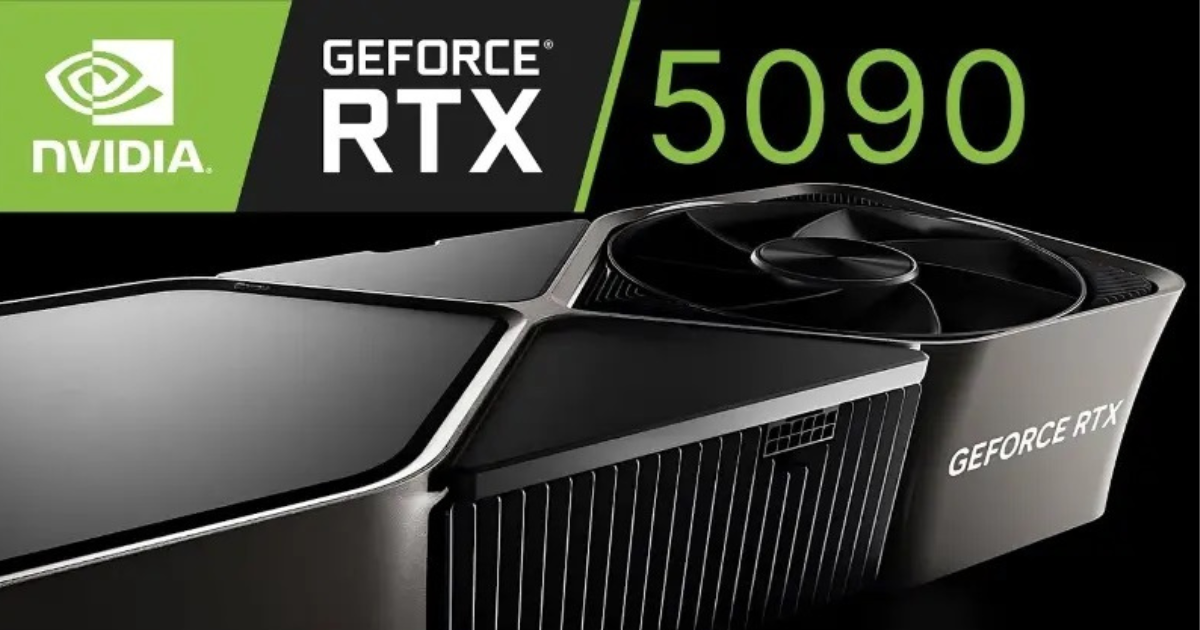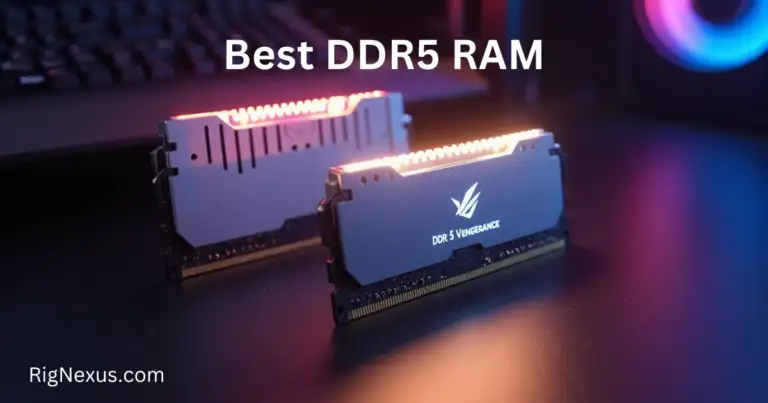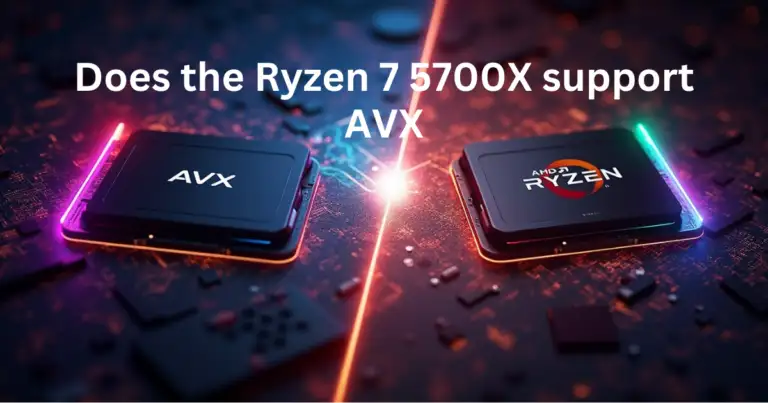An Overview of the RTX 5090: Specs, Price, and Release
The NVIDIA GeForce RTX 5090 has officially launched, redefining performance standards for gaming and professional graphics. As the flagship of NVIDIA’s new 5000-series, it offers remarkable improvements over its predecessors in visual quality, computational power, and innovative technology.
In this comprehensive post, we’ll dive into the RTX 5090’s key specifications, pricing, availability, and groundbreaking features, giving you an insider’s look at the future of high-performance GPUs. Whether you are a gamer, creator, or technology enthusiast, this GPU promises an exciting leap forward.
Table of Contents
Key Takeaways
- GPU Architecture: NVIDIA Blackwell
- CUDA Cores: 21,760
- Memory: 32GB GDDR7
- Ray Tracing & AI: 3rd-gen Ray Tracing Cores and 4th-gen Tensor Cores
- DLSS 4 Support: Enhanced AI upscaling for unbeatable performance
- Power Requirements: 450W TDP; 850W PSU recommended
- Release Date: January 30, 2025
- Price: $1,999
The Evolution of NVIDIA’s RTX Series
NVIDIA’s RTX lineup has consistently set industry benchmarks, introducing real-time ray tracing with the RTX 2000 series and further refining performance with the RTX 3000 and 4000 series. Each generation brought advancements in rendering, AI, and gaming performance, culminating in the revolutionary RTX 5090.
The RTX 2000 series introduced real-time ray tracing, giving developers tools to create lifelike lighting and shadow effects. With the RTX 3000 series, NVIDIA pushed the limits of ray tracing and DLSS (Deep Learning Super Sampling), bringing smoother gameplay to gamers worldwide. The RTX 4000 series refined these technologies and showcased incredible 4K gaming capabilities.
Now, with the RTX 5090, NVIDIA has taken another quantum leap, integrating the new Blackwell architecture to double the performance of its predecessor, while focusing on energy efficiency and enhanced AI capabilities. Gamers and creators alike can expect unprecedented realism and responsiveness.
RTX 5090 Specifications and Architecture
The RTX 5090 is built to dominate. Its Blackwell architecture leverages 21,760 CUDA cores and 32GB of ultra-fast GDDR7 memory, making it a powerhouse for 4K and 8K gaming, AI workloads, and professional content creation. Let’s break down the key specifications:
GPU Architecture: Blackwell
Blackwell architecture represents NVIDIA’s latest leap in GPU design, focusing on improved computational efficiency and scalability. Features include:
- Enhanced SM (Streaming Multiprocessor) design for greater throughput.
- Optimized for AI and deep learning tasks, leveraging its 4th-gen Tensor Cores.
- Reduced latency in gaming and real-time rendering tasks.

Memory and Bandwidth
The RTX 5090’s 32GB GDDR7 memory delivers 1.5x faster bandwidth compared to GDDR6X. This upgrade supports:
- Seamless 8K gaming and 3D rendering.
- Handling large datasets for AI training.
- Ultra-responsive multitasking across intensive applications.
Ray Tracing and AI
The RTX 5090 features:
- 3rd-gen Ray Tracing Cores for photorealistic visuals.
- 4th-gen Tensor Cores to boost DLSS 4 performance, enabling real-time AI-powered upscaling that doubles frame rates.
Expected Performance Benchmarks
Gaming Performance
The RTX 5090 redefines gaming experiences, delivering:
- 4K Gaming: Ultra-smooth gameplay at maximum settings in the latest AAA titles.
- 8K Gaming: Revolutionary performance, achieving playable frame rates with ray tracing enabled.
- DLSS 4 Boost: Leveraging AI upscaling to deliver higher frame rates without compromising visual fidelity.
For example, early benchmarks show the RTX 5090 achieving over 120 FPS in graphically demanding titles like “Cyberpunk 2077” at 4K with ray tracing maxed out. In 8K gaming, DLSS 4 ensures steady performance above 60 FPS, previously unattainable in this resolution.
Professional Applications
For creators, scientists, and engineers, the RTX 5090 shines in demanding workloads:
- 3D rendering: Rendering times in Blender or Maya are reduced by up to 50% compared to the RTX 4090.
- AI-driven tasks: Enhanced precision and speed in machine learning model training.
- Video editing: Effortless editing of 8K RAW video footage in real time.
Pricing and Availability
The RTX 5090 launched on January 30, 2025, with a price tag of $1,999. While its premium pricing reflects cutting-edge technology, its value is unmatched for enthusiasts and professionals alike. Availability may vary regionally, with high demand expected to impact stock levels initially.
Regional Pricing and Variations
Given the global demand, NVIDIA has worked to ensure widespread availability. However, factors like tariffs and taxes may slightly vary pricing by region. Gamers in Europe and Asia may see prices closer to $2,200 due to import fees.
Power Requirements and System Compatibility
The RTX 5090 demands robust system support. To fully leverage its capabilities, users should ensure their system meets the following requirements:
Power Supply and Cooling
- Power Supply: An 850W PSU or higher is recommended to accommodate the GPU’s 450W TDP and system stability.
- Cooling Solutions: High-performance air or liquid cooling solutions are ideal, especially for overclockers.
System Requirements
- Motherboard: PCIe Gen 5 compatibility ensures maximum bandwidth utilization.
- Processor: High-end CPUs such as the Intel Core i9-14900K or AMD Ryzen 9 7950X are recommended.
- RAM: At least 32GB DDR5 is essential for handling complex workloads and modern gaming requirements.
Release Timeline and Market Impact
The RTX 5090’s arrival has created waves in the GPU market. Its official launch on January 30, 2025, marks a major milestone in gaming and professional graphics. Early adopters are already praising its revolutionary performance, though stock shortages remain a concern due to high demand.
NVIDIA’s focus on improving efficiency and performance makes the RTX 5090 a standout choice for both gamers and creators. The card is poised to lead market trends and drive competition, especially with AMD’s upcoming rival GPUs.
Competitive Analysis
AMD’s Radeon RX 8000 Series
AMD has launched its RX 8000 series to compete with the RTX 5090. The flagship Radeon RX 8950 XT offers impressive performance at a slightly lower price point. While NVIDIA holds the edge in ray tracing and DLSS, AMD’s advancements in power efficiency and affordability present a strong challenge.
Market Impact
The RTX 5090’s premium pricing reflects its cutting-edge technology. However, its impact on the GPU market is significant. As competitors respond, consumers can expect innovations and potentially more competitive pricing in the high-end GPU segment.
Practical Applications for Gamers and Professionals
Gaming Experience
The RTX 5090 delivers:
- Seamless 4K and 8K gaming.
- Enhanced immersion with improved ray tracing.
- Support for next-gen titles optimized for DLSS 4.
Content Creation
For professionals, the RTX 5090 is a game-changer:
- Handles 3D rendering and video editing effortlessly.
- Accelerates machine learning and AI workflows.
- Supports multi-monitor setups for advanced productivity.
Advanced Streaming
- Leveraging NVIDIA Broadcast features for AI-enhanced streaming, such as background noise removal and virtual green screens.
- Supporting 4K 120 FPS streams with minimal latency.
Power Efficiency and Thermal Design
The RTX 5090 introduces innovations in power efficiency and cooling:
- TDP: 450W, requiring robust PSUs.
- Cooling Systems: Advanced air and liquid cooling solutions ensure optimal performance.
- Enhanced Design: Reduced thermal throttling for consistent output under heavy workloads.
FAQs
1. What makes the RTX 5090 stand out?
- Unprecedented performance, advanced ray tracing, DLSS 4, and 32GB GDDR7 memory.
2. How does it compare to the RTX 4090?
- The RTX 5090 offers up to 2x the performance in gaming and professional tasks.
3. What systems support the RTX 5090?
- Systems with PCIe Gen 5 slots, high-end CPUs, and robust cooling solutions.
4. When was it released?
- January 30, 2025.
5. What is the price of the RTX 5090?
- The MSRP is $1,999.
6. What are the power requirements?
- It requires a PSU of 850W or higher and advanced cooling systems.
**7. How will it handle gaming at 8K?




